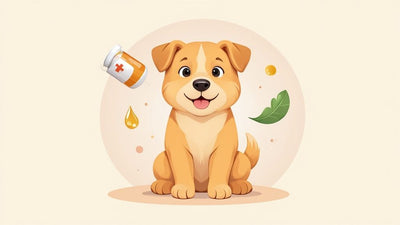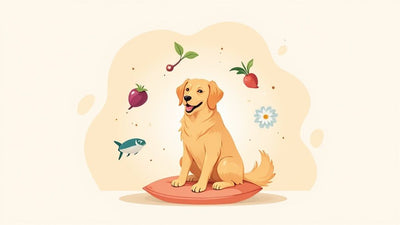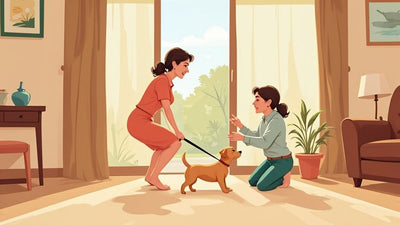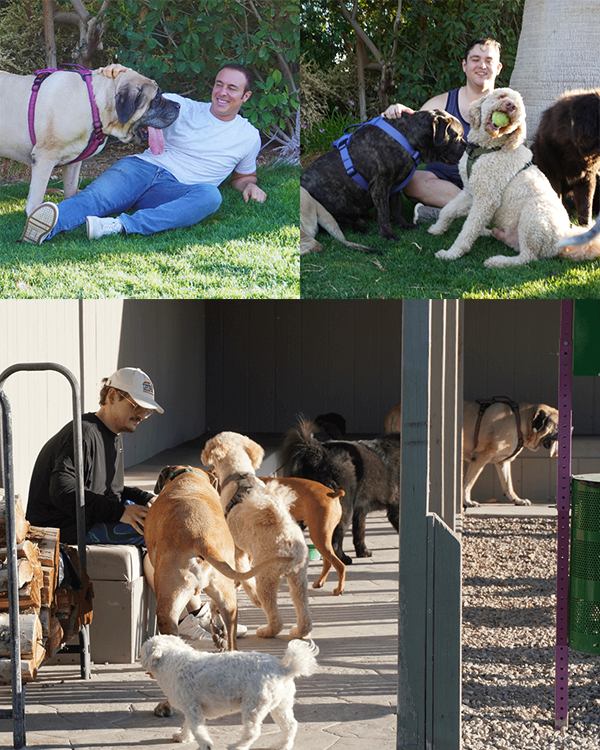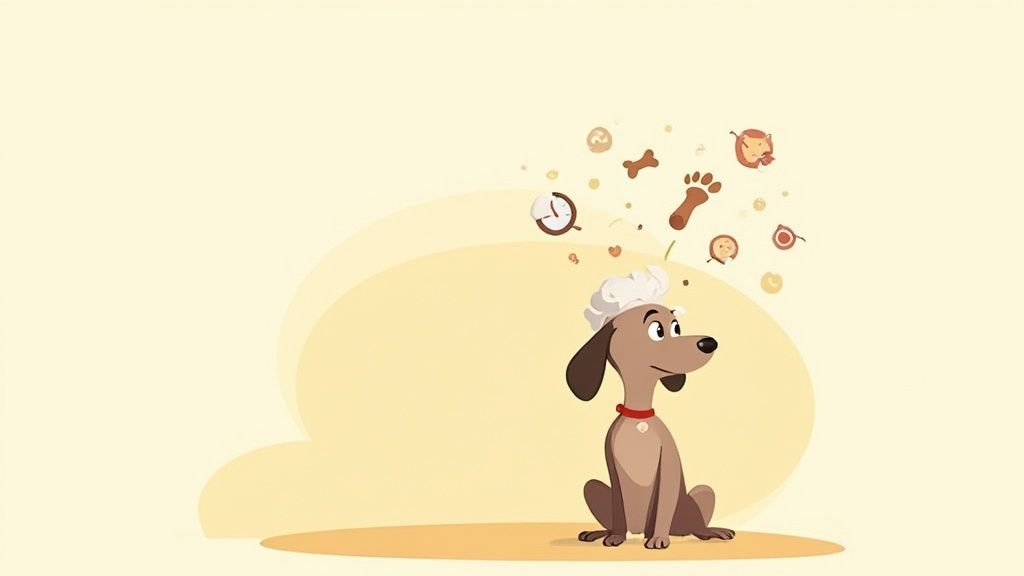
Your Guide to Dog Cognitive Dysfunction Syndrome
It starts with little things. Moments so subtle you might second-guess yourself.
Maybe your dog, who knows your home better than anyone, suddenly stands at the hinge side of the door. Or perhaps they get lost on the way from the water bowl back to their bed. These are the small, unsettling signs that often lead to those 3 AM internet searches.
If this sounds familiar, you're not alone, and you're not imagining it. These moments are often the first quiet whispers of dog cognitive dysfunction syndrome (CDS). It's an age-related condition, similar to Alzheimer's in people, that affects the brains of senior dogs, leading to changes in their cognitive abilities.
The illustration below captures one of those all-too-common moments of confusion that a senior dog might experience.
This image really hits home for anyone who has watched their old friend struggle with disorientation in a place that was once so familiar.
The Emotional Side of a CDS Diagnosis
It's one thing to read about CDS, but another thing entirely to watch the companion who has been your shadow for years suddenly seem lost. It can be absolutely heartbreaking. There's a unique kind of grief that comes with watching them navigate a world that seems to be shifting under their paws.
We understand because we’ve been there, too. Remember, this is not your fault. This is a new chapter in your journey together, one where your love and patience will mean more than ever before.
When your dog stops greeting you at the door or forgets the route of your daily walk, it can feel like you’re losing little pieces of the friend you’ve always known. These aren't just symptoms; they are signals that your dog needs a new kind of support. For a deeper look, our guide on aging dog behavior changes can offer more insight.
So, What’s Happening Inside Their Brain?
Let’s break it down simply. Think of your dog's brain as a busy city's road system that they've used their entire life. As they get older, just like in humans, this network can start to show some wear and tear.
"Brain clutter" can build up, making it harder for messages to travel smoothly between brain cells. This slowdown can affect all sorts of functions, which leads to the changes you're starting to see.
- Memory Lapses: Forgetting simple commands or where their food bowl is.
- Disorientation: Staring blankly at walls or getting "stuck" in corners.
- Altered Sleep Patterns: Pacing restlessly at night but sleeping more during the day.
Recognizing that these changes have a medical cause is a powerful first step. It moves you from worry to action, where you can start finding gentle ways to support their brain health. In this journey, small improvements—like a peaceful night's sleep—can feel like a huge victory.
2. Decoding the Signs of Canine Cognitive Dysfunction
Watching an old friend change can be tough. You know your dog better than anyone, and when their behavior starts to shift, it’s easy to feel a little lost yourself. You notice small, puzzling things, but it's hard to connect the dots.
Let's break down what those changes might look like. Veterinary behaviorists have a helpful acronym, DISHAA, to organize the common signs. It's a simple way to remember the key categories: Disorientation, Interactions, Sleep-wake cycles, House-soiling, Activity levels, and Anxiety.
Disorientation in Familiar Places
This is often one of the first and most unsettling signs. It’s as if your dog’s internal GPS has gone on the fritz, making them seem lost in the very home they’ve lived in for years.
You might see them:
- Staring blankly at a wall or into a corner.
- Getting physically "stuck" behind furniture and seeming unable to figure out how to back up.
- Forgetting familiar routines, like how to find their water bowl or which door leads to the backyard.
- Waiting at the wrong side of the door (the hinge side) to be let in or out.
These moments of confusion aren't just quirks; they're important clues. Recognizing them is the first step toward getting your dog the right kind of support.
Changes in Social Interactions
The bond you share is deep, so when their social habits change, it can feel personal. A dog navigating CDS might start interacting differently with you, other family members, and even other pets.
Your once-cuddly companion might become a bit more distant, or a previously independent dog could suddenly become your shadow. They might stop greeting you with the same enthusiasm at the door. This isn't a reflection of their love for you—it’s a sign of the confusing world they're now navigating.
Disrupted Sleep-Wake Cycles
Are your nights not as quiet as they used to be? A scrambled internal clock is a hallmark of canine cognitive dysfunction.
One of the most common and challenging things we hear is about the nighttime pacing. A dog who once slept soundly might now wander aimlessly all night, only to sleep more deeply during the day. This tells us the dog is likely feeling anxious and disoriented.
This isn't just "old age." A significant shift in sleep patterns is a clear sign that something more is going on. Helping them get restful nights can dramatically improve quality of life for everyone.
House-Soiling and Forgotten Training
It's incredibly frustrating when a dog who has been perfectly house-trained for years starts having accidents inside. For senior dogs, this often isn't a behavioral problem—it's a cognitive one. They may genuinely forget their long-held training.
They might not remember to signal that they need to go out, or they may have an accident just moments after coming back inside. It’s truly a lapse in memory, not an act of defiance. Understanding this helps us react with patience instead of frustration.
Shifting Activity Levels and Anxiety
Finally, you’ll often see a change in your dog’s overall activity and mood. They might show less interest in favorite toys, walks, or playtime.
At the same time, you may see an increase in aimless behaviors like repetitive pacing or circling. This is often accompanied by new or worsening anxiety. They might develop a fear of loud noises or seem distressed when left alone. This anxiety is a natural response to their growing confusion.
These signs are surprisingly common. One study of dogs between 11 and 16 years old found that 28% of the 11-to-12-year-olds showed signs of impairment. That number jumps to 68% for dogs aged 15 to 16. You can learn more about the study’s findings here.
By learning to spot these signs, you become your dog's most important advocate. The simple checklist below can help you organize your observations before speaking with your veterinarian.
Common Signs of CDS (DISHAA)
Use this simple checklist to identify behavioral changes associated with Dog Cognitive Dysfunction Syndrome.
| Category (DISHAA) | What You Might See at Home |
|---|---|
| Disorientation | Staring at walls, getting stuck in corners, seems lost in familiar places, goes to the wrong side of the door. |
| Interactions | Less interest in petting, seeks less attention, becomes more clingy, less enthusiasm for greetings. |
| Sleep-Wake Cycles | Sleeps more during the day, restless at night, pacing or wandering after dark, vocalizing at night. |
| House-Soiling | Forgets house-training, has accidents indoors shortly after being outside, doesn't signal to go out. |
| Activity | Less interest in playing, decreased exploration, repetitive behaviors (pacing, circling), less responsive to commands. |
| Anxiety | Increased fear of new places/people, new separation anxiety, more fearful of noises, general increase in irritability. |
Having these specific examples ready will help you have a much more productive conversation with your vet about how to best support your cherished friend through their golden years.
Get Your FREE Dog Brain Health Guide

Get instant FREE access to today's top ways to help your best friend live a longer, healthier, happier life.
- 39 value-packed pages of expert insights
- Early-detection tips for cognitive decline
- Top brain-boosting superfoods
- Vet-approved mental sharpness strategies
- Fun IQ tests for your dog
A Gentle Look Inside Your Dog's Aging Brain
It’s natural to ask "why" when the friend who’s always been so in tune with you suddenly seems lost. We understand. Understanding the science behind dog cognitive dysfunction doesn’t have to be complicated; it's about understanding the journey your old friend is on.
Think of your dog's brain as a busy city they've navigated their entire life. The pathways and communication lines are second nature. As they get older, though, some of that internal infrastructure starts to wear down, making messages a little slower.
The Problem of Brain Clutter
One of the main things happening inside an aging brain is the buildup of something called beta-amyloid plaques. You can just think of it as "brain clutter."
Imagine the city's communication lines getting slowly clogged over many years. When this clutter gathers between the brain cells (neurons), it gets in the way of the signals that help your dog think and remember. This is often why they might pause, looking confused, before finding their food bowl.
This buildup is a gradual process, but over time, it can impact how their brain works, leading to the behavioral changes you’re starting to notice at home.
"Small improvements can mean everything. Knowing why your dog is struggling helps you see that every moment of clarity is a win worth celebrating. It’s about more good days together."
Supporting the brain's natural cleanup processes through nutrition can help keep those vital communication pathways clearer.
Oxidative Stress: The Cellular Rust
Another key piece of the puzzle is oxidative stress. It sounds technical, but it’s helpful to think of it as "rust" forming on the delicate machinery of the brain cells.
Just like metal exposed to the elements, your dog's cells face daily wear and tear. This process creates unstable molecules called free radicals that can damage cells.
When dogs are young, their bodies have a robust antioxidant defense system to neutralize these free radicals. As they age, this system doesn't work as well. The imbalance leads to oxidative stress, which wears down brain cells and damages their ability to talk to each other.
Here’s how this "cellular rust" can show up in your dog's behavior:
- Slower Processing: It might take them a few extra seconds to respond when you call their name.
- Increased Anxiety: A brain working overtime just to process the world can easily lead to feelings of uncertainty.
- Disrupted Sleep: Their internal body clock can get thrown off, leading to those restless nights.
Gentle, natural support with antioxidants can give the body the tools it needs to maintain its defenses against oxidative stress, protecting those precious brain cells.
Reduced Blood Flow to the Brain
Finally, circulation is a huge factor. The brain is an incredibly energy-hungry organ. It needs a constant supply of oxygen and nutrients from the bloodstream to function. Think of it as the city’s power grid.
With age, blood flow to the brain can naturally decrease. This means the brain cells get less of the fuel they need. Supporting healthy circulation helps ensure these cells are properly nourished, which is critical for mental clarity. This is why supporting a dog with canine cognitive dysfunction requires a multi-pronged approach—clearing the clutter, protecting from rust, and keeping the power supply strong.
Partnering with Your Veterinarian for a Diagnosis
https://www.youtube.com/embed/eSOob8nozU4
Bringing up concerns about your dog’s cognitive health with your veterinarian can feel overwhelming. But it’s the most important first step. Think of it as building a team—with you and your vet working together for your best friend. This conversation is about getting answers and finding a path forward.
There’s no single, definitive test for canine cognitive dysfunction. Reaching a diagnosis is more like careful detective work. The goal is to first rule out other medical conditions that could be causing these new behaviors.
Ruling Out Other Health Concerns
Many common age-related health problems can look a lot like CDS. Is your dog having accidents inside because they’re forgetting their training, or because painful arthritis makes the trip to the back door too difficult? A dog who doesn't respond when you call might be confused, or they could be losing their hearing.
Your vet will want to investigate a few key areas to make sure nothing else is at play:
- Chronic Pain: Aches from arthritis or dental disease can cause a dog to become irritable or restless at night.
- Sensory Decline: As dogs age, their sight and hearing naturally fade. This can lead to what looks like disorientation or new anxieties.
- Systemic Illness: Conditions like kidney disease or thyroid imbalances can impact a dog's brain function.
- Neurological Issues: In some cases, symptoms could point to other brain-related problems, like a tumor or vestibular disease. If you're noticing a sudden head tilt, our article on vestibular disease in older dogs might offer some helpful insights.
A thorough physical exam, along with potential bloodwork, gives your vet the complete picture of your dog's physical health.
Being Your Dog’s Best Advocate
Nobody knows your dog better than you do. You see the small, day-to-day changes others might miss. To help your vet, it’s a great idea to come to your appointment prepared. Start a small journal or a note on your phone.
Instead of just saying, "he seems confused," try to be specific: "Yesterday, he got 'stuck' staring at the wall for five minutes." These details are gold.
You are your dog's most important observer. The notes you bring—about nighttime pacing or forgotten greetings—are invaluable pieces of the puzzle for your veterinarian.
It's important to remember that the likelihood of CDS climbs sharply as a dog gets older. Research shows that while it might affect around 8.1% of dogs between 8 and 11, that number rises to an estimated 67.3% for dogs aged 15 to 17. By documenting symptoms and speaking up early, you give your dog the best chance at getting the right support.
Taking this collaborative approach with your vet turns a period of worry into a proactive plan to maintain your dog’s comfort and quality of life for as long as possible.
Creating a Safe and Supportive Home Environment
When your dog's world starts to feel confusing, your home should be their safe harbor. Supporting a dog with dog cognitive dysfunction syndrome isn't about huge changes. It’s about the small, thoughtful adjustments you make every day to create a world that feels predictable and full of comfort.
It's normal to feel a bit lost yourself, wanting to help them find their way again. The good news is, you can. By focusing on their environment and daily rhythm, you can make a real difference and create more good days together.
The Power of a Predictable Routine
For a dog navigating the fog of cognitive decline, consistency is everything. A predictable daily schedule acts as a comforting anchor, reducing the anxiety they might be feeling.
When they know what to expect, their brain doesn’t have to work so hard to process the world. This simple structure is one of the kindest things you can offer.
"We measure success in peaceful nights and moments of recognition. A consistent routine is one of the kindest gifts you can give a dog with CDS, as it helps their world feel safe and manageable again."
Try to lock in consistent times for these key activities:
- Mealtimes: Feed your dog at the same times each day. This helps regulate their internal clock.
- Potty Breaks: Take them out frequently, especially first thing in the morning, after meals, and right before bed. Always use the same door to minimize confusion.
- Bedtime: A quiet, steady wind-down routine signals that it's time to rest, which can be a game-changer for reducing nighttime pacing.
Adapting Your Home for Safety and Comfort
It's heartbreaking to watch your old friend get "stuck" in a corner. You can make their physical space much easier to navigate with a few simple tweaks that boost their confidence and keep them safe.
Think of it as adding guardrails to their world. These small changes can prevent a lot of stress for both of you.
Simple Home Modifications:
- Add Non-Slip Surfaces: Lay down rugs or runners on slippery floors. This gives them better traction and helps dogs also dealing with arthritis.
- Install Nightlights: Gentle nightlights in hallways and near their bed can make a world of difference for a disoriented dog navigating in the dark.
- Clear the Pathways: Keep floors free of clutter and avoid rearranging the furniture. A consistent layout lets them rely on muscle memory.
- Use Gates Safely: If you have stairs, block them off with a baby gate to prevent falls, especially if they’ve started to wander.
Gentle Enrichment for a Healthy Mind
Keeping an aging dog's mind engaged is so important, but the key is to adapt activities to their current abilities. The goal is gentle stimulation, not a stressful challenge.
Just how important is this? A study from the Dog Aging Project, looking at over 15,000 dogs, found that inactive dogs had 6.47 times the odds of developing CDS compared to very active dogs of a similar age. This is powerful evidence that keeping them moving—physically and mentally—can play a huge role in their brain health. You can find more details in this groundbreaking study on dog cognitive health.
Here are a few ideas for gentle, low-stress enrichment:
- Food Puzzles: Use simple, level-one puzzle toys or a "snuffle mat" that encourages them to use their powerful nose to find treats.
- Scent Work: Hide a few smelly treats around a single room and let them "hunt" for them at their own pace.
- Short, "Sniffy" Walks: Let them lead the way on walks. Allowing plenty of time for sniffing is fantastic mental exercise.
Nutritional Support for Brain Health
Just as we adapt their physical world, we can also provide support from the inside out. Nutrition is a cornerstone of supporting a dog with dog cognitive dysfunction syndrome. The right nutrients can help protect brain cells and maintain their function.
Think of it as giving their brain the essential building blocks it needs to maintain its structure and keep communication lines open.
Brain-Supportive Nutrients to Consider:
- Antioxidants: Ingredients like vitamins E and C help protect brain cells from oxidative damage—that "cellular rust" we talked about.
- Omega-3 Fatty Acids: These healthy fats, often from fish oil, are vital for brain cell structure and can help support cognitive function.
- Phosphatidylserine: A natural component that acts as a key building block for brain cells, helping to maintain cell health and communication.
By combining a safe environment, a predictable routine, gentle mental activity, and targeted nutritional support, you create a complete plan for your best friend. Every small adjustment is an act of love.

Support Your Dog's Brain Health with NeuroChew™
As mentioned in this article, NeuroChew is the first dog chew designed to support both cognitive function and healthy circulation. Perfect for dogs showing early signs of cognitive decline or for proactive brain health support.
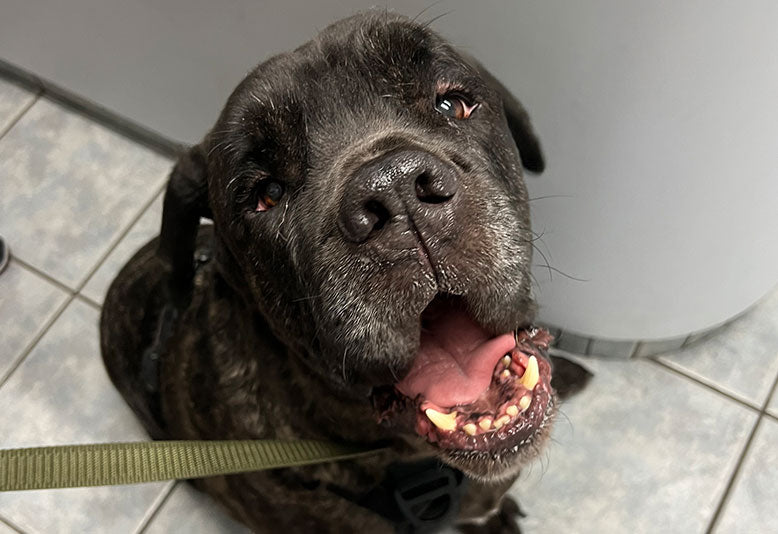
Real Results: How NeuroChew Helped Brutus Regain His Mental Clarity
Brutus was getting disoriented at night. After starting NeuroChew, he's more happy during the day and steady at night. He's back to his old self!
Focusing on Comfort and Connection on the Journey Ahead
Getting a diagnosis for dog cognitive dysfunction syndrome can be heartbreaking. We get it. But this isn't just an ending; it's a new chapter in your journey together, one that calls for even more patience, care, and connection.
Your dog gave you their best years, full of unconditional love. Now, it’s your turn to give them yours. Your focus becomes ensuring their golden years are as comfortable, safe, and loving as possible. It's less about a search for a cure and more about providing steadfast support.
Cherishing the Moments of Clarity
You're going to have good days and tough days. A huge part of this new journey is learning to celebrate the little victories—the moments of progress that suddenly mean the world.
When a dog with CDS sleeps peacefully through the night without pacing, that’s a win. When they greet you with a familiar wag or find their favorite sunbeam on their own, those moments of clarity are pure gold. They’re a powerful reminder that the companion you’ve always known is still in there.
We start measuring success in quiet nights and flickers of recognition. These small improvements are what this journey is all about, showing that our efforts to bring them comfort are making a real difference.
Learning to savor these moments helps shift your mindset from sadness to one of gentle hope, centered on creating as many good moments as you can.
Adapting Your Expectations with Grace
Your relationship with your dog will change, and that's okay. Those long hikes might be a thing of the past, but a slow, sniff-filled stroll around the block can be just as meaningful. They might not always come when called, but a gentle pat or just sitting beside them speaks volumes.
This stage is about adjusting your expectations with compassion. It means meeting your dog exactly where they are, day by day. You are their anchor. Every small change you make—like adding a nightlight or providing targeted nutrition—is a profound act of love. On the nutrition front, specific supplements can make a difference. For example, you can learn more about how phosphatidylserine for dogs can help support brain cell health.
You Are Not Alone on This Path
Above all, remember you aren't walking this road by yourself. There's a whole community of pet parents who know the challenges and rewards of caring for an aging dog. Every routine you stick to, every gentle word you speak, and every ounce of patience you show is a testament to the incredible bond you share.
This is the ultimate expression of love—being there for them when they need you the most. Your presence, your care, and your unwavering affection are the most powerful support there is. Together, you can navigate this chapter with dignity, comfort, and love.
Answering Your Questions About CDS
When your dog is diagnosed with cognitive dysfunction, it's natural to have a million questions. It’s a confusing and emotional time, and you’re certainly not alone. Let's walk through some of the most common concerns we hear from pet parents.
Is My Dog in Pain With Cognitive Dysfunction?
This is a big one. Thankfully, the condition itself doesn't seem to cause direct physical pain like arthritis would. The distress from CDS is more psychological. Imagine the anxiety a dog might feel when they suddenly can't recognize their own backyard or the stress from a scrambled sleep schedule.
That emotional toll is very real. Our main goal is to reduce that confusion and anxiety by creating a safe, predictable world for them, bringing them a sense of comfort and security.
How Fast Does Dog Dementia Progress?
Every owner wants to know what the timeline looks like, but the honest answer is: it's different for every dog. For some, the changes are slow and subtle over a few years. For others, the changes can feel much faster.
A dog's breed, their overall health, and the supportive care they get all play a part in how their journey unfolds. That's why we always focus on meeting their needs in the here and now, aiming for one good day at a time.
Can I Stop My Dog From Getting CDS?
There's no way to completely prevent dog cognitive dysfunction syndrome. However, you can absolutely take steps to support your dog’s brain health throughout their life. It's a lot like human health—a healthy lifestyle can build resilience and may help lessen the impact of age-related changes.
"This is a question that comes from a place of deep love. The best thing we can do is focus on a lifetime of wellness. It's a powerful investment in their future."
Think of it as building a "cognitive reserve" for them over the years. This isn't complicated. It boils down to a few key things:
- Regular, Gentle Exercise: Keeping their body moving helps maintain good blood flow to the brain.
- Ongoing Mental Stimulation: Simple puzzle toys or nose work games keep their mind sharp.
- A Brain-Healthy Diet: Foods rich in antioxidants and Omega-3 fatty acids are fantastic for supporting brain cells.
Making these small things a consistent part of their life can make a real difference when they reach their senior years.
At Furever Active, our mission is to support your dog’s brain health for the long haul. We formulated our NeuroChew™ supplement to offer natural, gentle support for their mental clarity and comfort, so you and your best friend can make the most of your time together. Explore how NeuroChew™ can support your dog's journey.
Share This Article

Support Your Dog's Brain Health with NeuroChew™
The first dog chew that supports both brain function and healthy circulation. Perfect for dogs of all ages.
- Enhances cognitive function & mental clarity
- Reduces anxiety without sedation
- Supports healthy blood circulation
- Made in USA with natural ingredients
60-Day Money-Back Guarantee • Free Shipping



